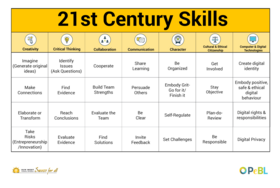Creativity Guidebook - K-5 (Elementary) Sun West
Creativity Elementary K-5
Purpose
Creativity is widely acknowledged to be a key 21st century skill and included in many countries’ desired college & career ready outcomes for students. Humanity has been fascinated by the creative process for millennia. But what do we know about creativity?
- Creativity has been well defined
- Numerous models have been developed to help enhance creativity
- Neurological workings of creativity are widely understood
- All students have creative potential
- Creative competence can be developed and supported by thoughtful interventions
- Methods of assessing creativity are well defined
- Instructional models to enhance creativity exist but are not widely used in schools
Creativity. P21 Partnership for 21st Century Learning. http://www.p21.org/our-work/4cs-research-series/creativity. Web. May 7, 2018
Why is this important?
Creativity is a key 21st Century skills that students need to embody in order to create and share unique and original ideas. Having the skills and abilities to imagine, make connections, elaborate and transform, and task risks, allows students to be successful participants in the planning of their learning and assessment.
Key Steps in Teaching Creativity Strategies
- Isolate the skill needed to be taught.
- Provide students with direct teaching to learn strategies and practice self-awareness.
- Provide and allow opportunities for students to practice the skills and strategies, and reflect often. This takes time at first, but students are rewarded for their efforts once they are able to master their practiced skill.
- Revisit strategies and skills often.
Explicit Teaching
To be able to learn and grow in 21st Century Competency understanding, it is important to teach each skill and let students experience what each skill looks like as well as how you can grow in each area. Caution: by simply saying the word "communication or collaboration...etc" students may not get a full understanding of each skill. Explicitly teaching and utilizing skills in different ways is what will ultimately promote deep understanding and growth in 21st Century Competencies.
Timeline Suggestions for Explicit Teaching
It is best to introduce one or two skills at a time, explicitly discuss them, and practice them over a short period of time initially to help set the foundation for future learning.
It is very important that a common language is used from the point the skill is introduced on, and that the skills you have explicitly taught are resurfaced and re discussed and reflected on regularly throughout the year.
Lesson Plans
Imagine (Generate original ideas)
Language in this rubric includes comparing things by relating them to something similar, explaining their importance in the world, designing original performances, ideas, models, or solutions to a problem. Opportunities for students to do such activities can be provided through:
- Genius Hour / Passion Projects/Wonder Time
- Maker Spaces
- STEAM/STEM activities
- Breakout Boxes or Breakout EDU provide excellent opportunities for students to compare and relate, explain, design, and find solutions to a problem.
Providing assessment choices for projects that include performances, models, etc:
Make Connections
Students can be explicitly taught to make connections in their own lives by first learning how to make connections in their reading.
Picture Rubric for Making Connections
Teach students about schema, what there's is, and how they can use it!
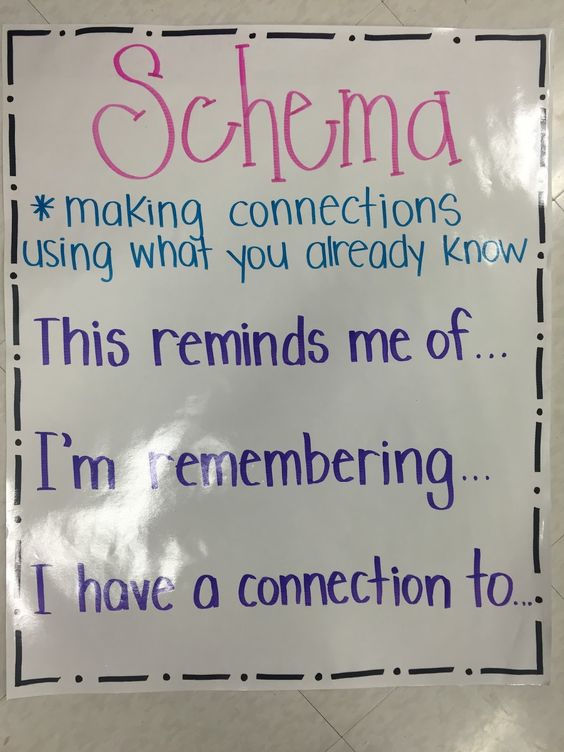
Schema
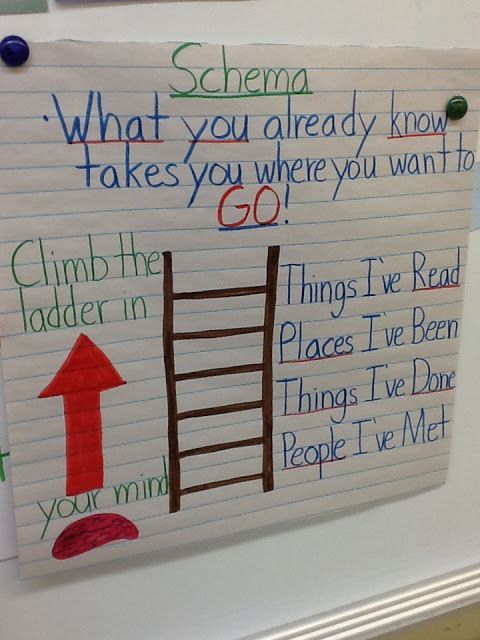
Schema
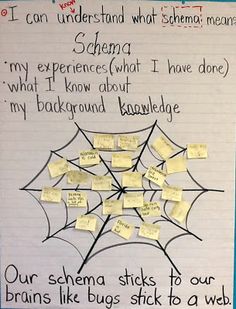
Schema Web
Elaborate or Transform
Teaching Students to Elaborate in Their Writing
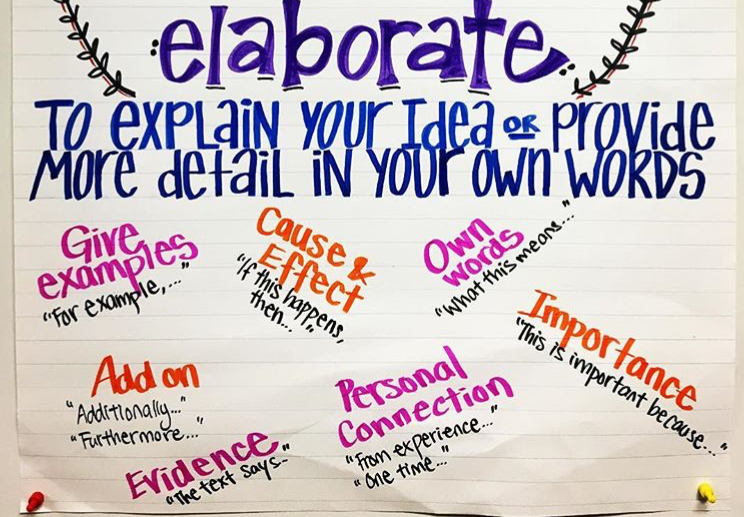
Elaborate
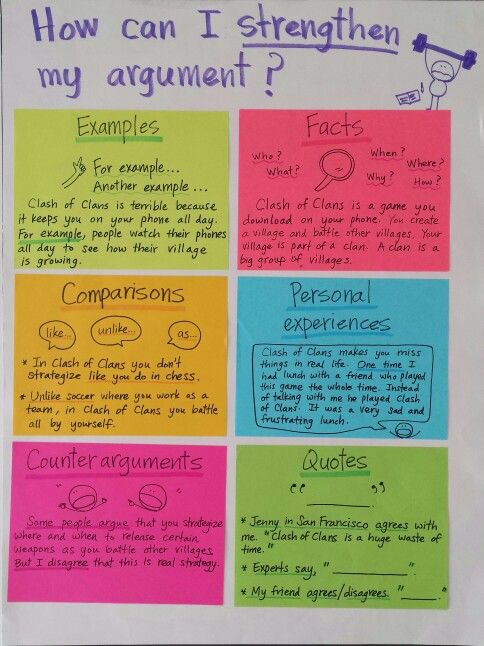
https://i.pinimg.com/736x/23/2c/fd/232cfd16f0281d4c07e39acd2ee300b7.jpg
Take Risks (Entrepreneurship/Innovation)
Caine's Arcade Lesson (Creativity & Imagination)- This lesson helps define imagination and creativity and explain how it helps us learn and about ourselves and the world. Caine created a massive cardboard arcade and is the inspiration behind this lesson.
14 books to teach children about Risk Taking
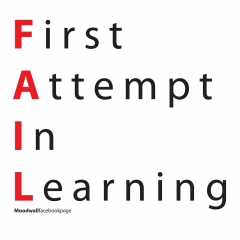
7 Tips for Moving Students to a Growth Mindset
Graphic Organizer for Risk Taking
Integration of Skills
Intentional integration of 21st Century Competency language in all day-to-day activities supports the development of routine reflection, skill use, and growth in support of curricular knowledge acquisition.
Why?
If we do not intentionally integrate 21st Century Competency connections into our learning environments, it is easy to forget about them. As the language becomes routine, growth in skills can and should be explored regularly. Ultimately the 21st Century Competencies are the skills needed to be successful in all day-to-day activities as well as future career opportunities. By being intentional in integrating the language and skill use in all aspects of learning, understanding of the skills can be applied and reflected upon to look for areas of potential growth and application.
How?
Once skills have been explicitly taught, integration of 21st Century Competencies can be achieved by connecting skills to all curricular areas, participating in pre-and post reflections (allowing students to predict which skills will be needed and subsequently which skills need to be worked on) and the use of 21st Century Competency rubrics to track growth.
Example: by using learner profile data, students can reflect on which skills they need to employ for a particular activity and based on this information, choose group members that have strengths or challenges in those skill areas.
Examples
When integrating 21 Century Competency language in all areas of learning consider the following curricular connected resources.
As you use similar resources in your own learning environment, how can you relate them back to growth and understanding of the 21 Century Competencies?
In ELA
This will likely be your focus area with creativity. Be sure to included regular lessons on the following topics, and providing ample opportunity to practice, share and reflect.
- Being imaginative can be demonstrated throughout ELA in any variety of Compose and Create outcomes.
- Explicitly teaching how to make connections links to ELA Comprehend and Respond outcomes.
- Have students practice their elaborate and transform skills by adding details and other's perspectives in their ELA work.
- Teach students take risks and encourage their innovation in ELA assignments.
In Math
Creativity is important in all areas of school and life, and should also be discussed, modeled and used in Math. Be sure to include the following opportunities for your students:
- Teach students how to generate original ideas for solving problems.
- Students should take creative approaches to and apply unique ways of learning to their math.
- Teach students to take risks and explore different ways of thinking to solve math problems.
Teachable moments
Whenever a question, situation, comment or activity that involves a connection to a 21 Century Competency arises, take a moment to talk to students about it. Discussing skills, how they integrate into everything you do in life makes the reflection on the importance of skills a habit. This habit will instill a growth mindset around developing skills to their fullest potential. Teachable moments can be as short as 20 seconds. Make it your habit and it will become theirs!
Tracking Growth
When considering 21st Century Competency application, it is essential for both the teacher and the student to track growth. There is clear potential for growth in skill use throughout our lives. To ensure growth and understanding of application is taking place, we can easily track progression using rubrics, checklists, and self-assessments.
Formative Assessment
Formative assessments of 21st Century Competencies include anecdotal documentation, self-assessments and rubric check-ins. These formative assessments provide snapshots of growth throughout the learning process and allow goal setting to take place.
Assessing Growth
Reflection Document: https://resourcebank.ca/authoring/447-21st-century-secret-skill-reflections
Summative Assessment
Exemplar Rubrics
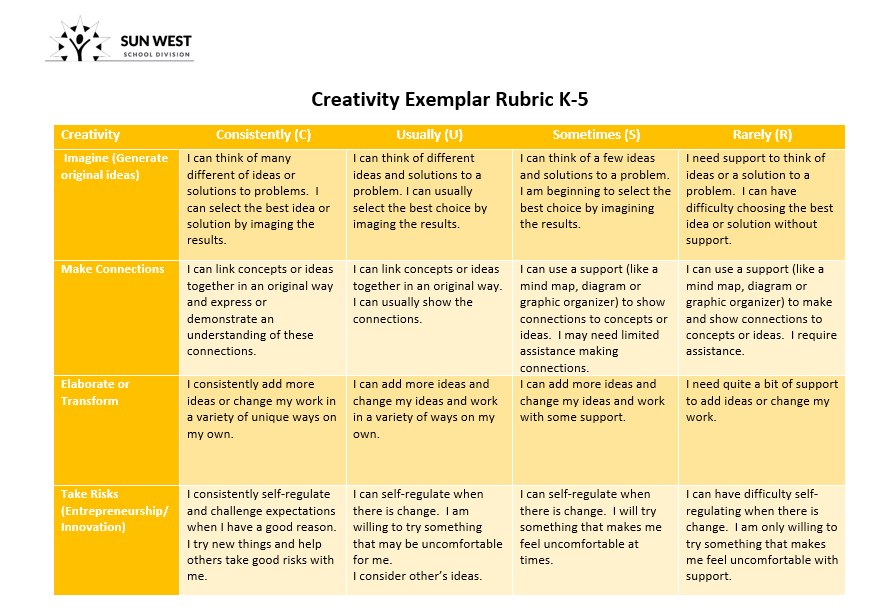
Creativity K-5

Creativity Rubric K to 5
Co-creating Rubrics
Exemplar rubrics have been developed for K-5, 6-9 and 10-12. To connect fully with students in their understanding of skill application and growth, a recommendation would be to re-write the rubric with the students to include their understanding of the skill, goals for integration in learning and commitment to the skill development.
Resources
Sun West Resource Bank Elementary Creativity Resources
Print based
Canadian Character Education- Bartier, Janet & William Young
Videos
Interactive
Educational Articles
11 Benefits of Encouraging Risk Taking in Your Children
